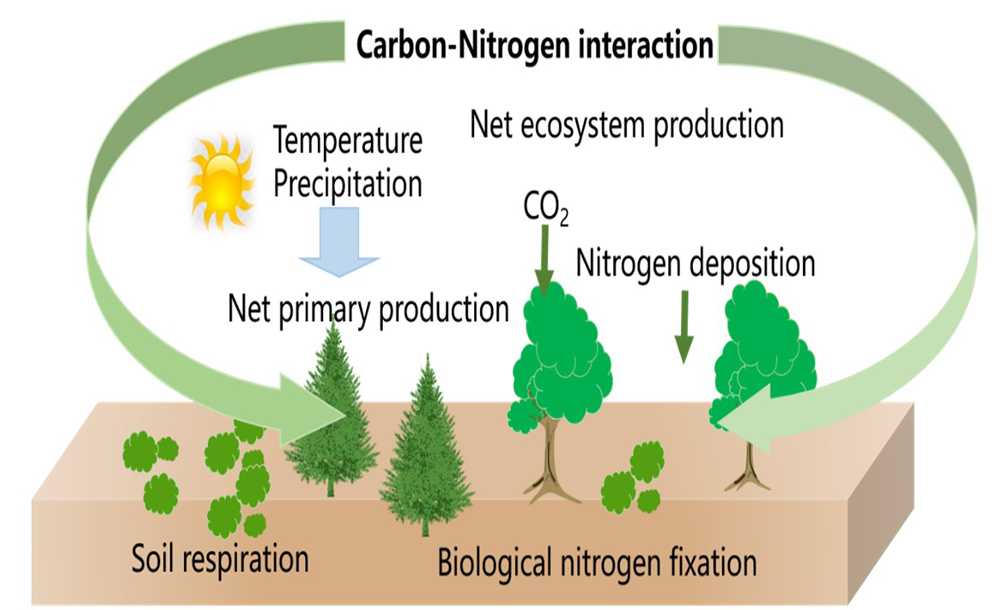The Belt and Road initiative, comprising countries in regions such as eastern Asia, central Eurasia, northern Africa and western Europe, is a key region for estimating the carbon sink trends under the target of carbon neutrality. Climate change, atmospheric CO
2 concentrations, biological nitrogen fixation, and anthropogenic nitrogen deposition could all influence the trends in net primary production, soil respiration and net ecosystem production.
According to a new research published in
Atmospheric and Oceanic Science Letters, the effects of climate change, elevating atmospheric CO
2, and increasing biological nitrogen fixation and anthropogenic nitrogen deposition are expected to affect the carbon sink trends of the Belt and Road region in the last 70 years of the 21st century. For example, enhanced surface air temperature and atmospheric CO
2 can both stimulate net ecosystem production. On the one hand, through rising CO
2 concentrations, net primary production may be promoted, and more carbon can be sequestered. On the other hand, increasing temperatures can stimulate soil respiration and promote carbon release. The combined strength of the two will determine the direction and strength of the net ecosystem production trend. Currently, however, the direction and magnitude of net ecosystem production trends and their responses to climate change, atmospheric CO
2 concentrations, biological nitrogen fixation, and atmospheric nitrogen deposition are controversial.
Schematic diagram of the underestimation of the carbon sink trend across the Belt and Road region during 2031–2100. (Image by PENG Jing)
Dr. PENG Jing from the Institute of Atmospheric Physics, Chinese Academy of Sciences, and colleagues, simulated the response of net primary production, soil respiration and net ecosystem production in the Belt and Road region to global changes from 1901 to 2100. Assuming a business-as-usual emissions scenario in the future (namely, RCP8.5), the net ecosystem production trend decreases by 0.04 Pg C yr-2 from 2031 to 2100 relative to historical levels (1936–2005).
"Increasing surface air temperature mainly results in this change, which drives a greater decreasing trend in net primary production than in soil respiration," explains Dr. PENG. The study reveals that higher biological nitrogen fixation leads to a greater increasing trend in soil respiration than in net primary production during 2031–2100 when compared to historical levels, which contributes to a reduction in the net ecosystem production trend by ~40%. It is worth noting that the projected stress of the decreasing trend in the carbon sink is more than twice that of CMIP6 (phase 6 of the Coupled Model Intercomparison Project), most models from which do not consider carbon–nitrogen interactions.
According to this study, global changes may have cascading effects on carbon sink trends across the Belt and Road region in the future, including the responses of net primary production and soil respiration to climate change, CO2 concentrations, biological nitrogen fixation and atmospheric nitrogen deposition. However, there remains a lack of understanding regarding the impacts of changes in land use, use of nitrogen fertilizer, and feedbacks between nitrogen and phosphorus. "All these factors could affect the trend and spatial distribution of net ecosystem production", adds Dr. PENG.
Citation:
Jing Peng, Li Dan, Xiba Tang, Fuqiang Yang, 2022, Trends in carbon sink along the Belt and Road in the future under high emission scenario, Atmospheric and Oceanic Science Letters, 100149, https://doi.org/10.1016/j.aosl.2022.100149.
Media contact: Ms. LIN Zheng, jennylin@mail.iap.ac.cn

